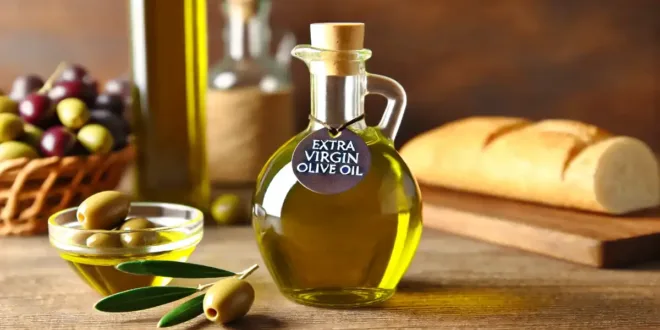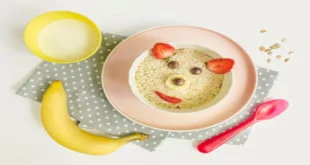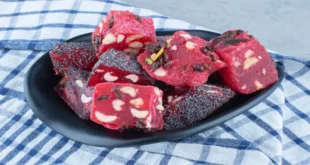I. Introduction
A. Definition of EVOO (Extra Virgin Olive Oil)
Extra Virgin Olive Oil, commonly referred to as EVOO Food, is not just any oil; it represents the pinnacle of olive oil production, celebrated for its superior quality, taste, and health benefits. Unlike other forms of olive oil, EVOO is made from pure, cold-pressed olives, ensuring that the oil retains all its natural nutrients and flavors. It stands apart from other types of olive oils like virgin or refined olive oil due to its method of extraction and the strict standards it must meet. EVOO is characterized by its low acidity (less than 0.8%), vibrant green color, and a rich, complex flavor profile that includes fruity, bitter, and pungent notes.
The significance of EVOO extends beyond its culinary uses. It has been a cornerstone of Mediterranean culture for thousands of years, used not only in cooking but also in religious rituals, medicine, and cosmetics. The ancient Greeks and Romans revered olive oil, considering it a gift from the gods, and it was often used as a symbol of peace and prosperity. Today, EVOO remains a staple in Mediterranean cuisine, embodying the region’s rich culinary heritage and commitment to healthy living.
B. Importance of EVOO in Culinary Arts
EVOO’s role in the culinary world is vast and varied. It is more than just a cooking oil; it is a key ingredient that enhances the flavor, texture, and nutritional value of countless dishes. From being the base of salad dressings and marinades to serving as a finishing touch on grilled vegetables or pasta, EVOO is a versatile kitchen staple that can elevate even the simplest meals.
In modern cooking, EVOO is prized for its ability to impart a distinct flavor to dishes without overpowering other ingredients. Its health benefits, including being rich in monounsaturated fats and antioxidants, make it a preferred choice for health-conscious cooks and chefs around the globe. This article delves into the many facets of EVOO, exploring its production, culinary applications, health benefits, cultural significance, and more, providing a comprehensive understanding of why this oil is cherished worldwide.
II. The Production and Quality of EVOO
A. How EVOO is Made
The production of EVOO is a meticulous process that begins with the careful selection of olives. The olives are harvested at the perfect ripeness and are immediately cold-pressed to extract the oil. Cold pressing is crucial because it ensures that the oil is not exposed to high temperatures, which can degrade its nutritional content and flavor. The entire process, from harvest to extraction, must be handled with precision to maintain the oil’s purity and quality.
Unlike other olive oils, which may undergo refining processes involving heat and chemicals, EVOO is the least processed form of olive oil. This minimal processing preserves the natural antioxidants, vitamins, and other beneficial compounds found in the olives. The result is an oil that is not only flavorful but also packed with health-promoting properties.
B. Quality Indicators
Several factors determine the quality of EVOO, making it essential for consumers to know what to look for when selecting this oil. Acidity is one of the primary indicators of quality; EVOO must have an acidity level below 0.8%, which indicates that the olives were processed quickly and under optimal conditions. A low acidity level is associated with a fresh, pure oil that has not undergone oxidation.
Another key indicator is the flavor profile. High-quality EVOO will have a balanced taste that includes a mix of fruity, bitter, and pungent notes. The bitterness and pungency are indicators of the presence of polyphenols, powerful antioxidants that contribute to the oil’s health benefits.
The origin and variety of olives also play a significant role in determining the quality of EVOO. Different regions produce olives with unique flavor profiles, influenced by the local climate, soil, and cultivation practices. Understanding the origin can help consumers appreciate the diversity of flavors available in EVOO.
C. Identifying Authentic EVOO
With the increasing popularity of EVOO, the market has seen a rise in counterfeit or mislabeled products. To ensure that you are purchasing authentic, high-quality EVOO, it is essential to be an informed consumer. Start by checking the label for key information such as the harvest date, origin, and certification marks from recognized authorities. Look for terms like “cold-pressed” and “unfiltered,” which indicate that the oil has been minimally processed.
It’s also important to be wary of common myths, such as the belief that the color of the oil is a reliable indicator of quality. In reality, the color of EVOO can vary widely depending on the type of olives used and the time of harvest. Instead, focus on the taste, aroma, and labeling information to make an informed choice.
III. Culinary Uses of EVOO
A. EVOO in Cooking
1. Low to Medium Heat Cooking
EVOO is a versatile oil that can be used in various cooking methods, but it is best suited for low to medium heat cooking. This includes sautéing, roasting, and light frying, where the oil’s unique flavor can enhance the dish without being compromised by high temperatures. The smoke point of EVOO, which is the temperature at which it begins to break down and produce smoke, is around 375°F (190°C). Cooking at temperatures above this can lead to the degradation of the oil’s beneficial compounds and the development of off-flavors.
When used within its optimal temperature range, EVOO can add depth and richness to dishes like sautéed vegetables, grilled meats, and roasted potatoes. The oil’s ability to complement rather than overpower other flavors makes it a favorite among chefs and home cooks alike.
2. Baking with EVOO
While butter is the traditional fat used in baking, EVOO offers a healthier alternative that can add a unique flavor to baked goods. It can be substituted for butter or other oils in recipes for bread, cakes, and cookies, providing a moist texture and a subtle, fruity flavor. EVOO works particularly well in recipes that call for nuts, citrus, or herbs, as it enhances these flavors.
When baking with EVOO, it’s important to choose a mild variety that won’t overwhelm the other ingredients. Light or delicate EVOO is ideal for cakes and pastries, while more robust oils can be used in savory baked goods like focaccia or olive bread.
B. EVOO as a Finishing Oil
1. Drizzling on Dishes
One of the simplest and most effective ways to use EVOO is as a finishing oil. Drizzling a high-quality EVOO over a dish just before serving can elevate the flavors and add a touch of luxury. This technique is commonly used in Mediterranean cuisine, where EVOO is drizzled over pasta, grilled vegetables, and soups to enhance their taste and aroma.
The key to using EVOO as a finishing oil is to choose a variety that complements the dish. For example, a peppery EVOO can add a pleasant bite to a tomato salad, while a fruity oil can balance the richness of a creamy soup.
2. Salad Dressings and Marinades
EVOO is a cornerstone of salad dressings and marinades, where it serves as both a flavoring agent and a carrier for other ingredients. When making a vinaigrette, EVOO is typically combined with an acid such as vinegar or lemon juice, along with seasonings like garlic, mustard, or herbs. The result is a dressing that is both flavorful and nourishing.
In marinades, EVOO helps to tenderize meat, poultry, or fish while infusing it with flavor. The oil’s ability to penetrate the surface of proteins allows the other marinade ingredients to be absorbed more effectively, resulting in a dish that is flavorful throughout.
C. EVOO in Traditional and Modern Cuisine
1. Mediterranean Dishes
EVOO is an essential ingredient in many traditional Mediterranean dishes, where it is used both for cooking and as a finishing touch. Dishes like bruschetta, tzatziki, and hummus rely on EVOO to provide richness and depth of flavor. In these dishes, the quality of the EVOO is paramount, as it is often one of the main components.
For example, in bruschetta, the bread is toasted and then rubbed with garlic before being drizzled with EVOO and topped with tomatoes and basil. The simplicity of the ingredients allows the flavor of the EVOO to shine, making it a critical element of the dish.
2. Global Influence
While EVOO is traditionally associated with Mediterranean cuisine, its popularity has spread worldwide, influencing a wide range of culinary traditions. In non-Mediterranean cuisines, EVOO is often used in fusion dishes that combine elements from different cultures. For example, EVOO might be used in a Japanese-inspired salad dressing or as a finishing oil for a Middle Eastern-style grain bowl.
The versatility of EVOO makes it a valuable ingredient in global cooking, where it can be used to add a touch of Mediterranean flair to a wide variety of dishes.
IV. Health Benefits of EVOO
A. Nutritional Profile
EVOO is not only a culinary gem but also a nutritional powerhouse. It is rich in monounsaturated fats, particularly oleic acid, which is known for its heart-healthy properties. These fats are more stable than polyunsaturated fats, making EVOO a healthier choice for cooking and eating.
In addition to healthy fats, EVOO contains a wealth of antioxidants, including polyphenols, which have been shown to have anti-inflammatory and disease-fighting properties. It also provides essential vitamins like vitamin E and K, which contribute to skin health, immune function, and blood clotting.
B. Cardiovascular Health
The connection between EVOO and cardiovascular health is well-documented, with numerous studies supporting its role in reducing the risk of heart disease. Regular consumption of EVOO has been shown to lower LDL (bad) cholesterol levels while maintaining or even increasing HDL (good) cholesterol. This balance is crucial for preventing the buildup of plaque in the arteries, which can lead to heart attacks and strokes.
The Mediterranean diet, which heavily features EVOO, has been associated with a lower incidence of cardiovascular disease. This diet emphasizes the consumption of fruits, vegetables, whole grains, and healthy fats, with EVOO being the primary source of fat. The diet’s success in promoting heart health is largely attributed to the regular intake of EVOO.
C. Anti-Inflammatory and Antioxidant Properties
Chronic inflammation is a major contributor to many diseases, including cancer, diabetes, and Alzheimer’s disease. The anti-inflammatory properties of EVOO are primarily due to its high content of oleocanthal, a compound that has been shown to have effects similar to those of ibuprofen, a common anti-inflammatory drug.
The antioxidants in EVOO, particularly polyphenols, help to combat oxidative stress, which is a major factor in the aging process and the development of chronic diseases. By neutralizing free radicals, these antioxidants help to protect cells from damage and reduce the risk of various health conditions.
D. EVOO in Weight Management
Contrary to the common misconception that fats lead to weight gain, healthy fats like those found in EVOO can actually support weight management. Monounsaturated fats are more satisfying than carbohydrates or protein, helping to reduce hunger and prevent overeating. This makes EVOO a valuable addition to a balanced diet aimed at maintaining a healthy weight.
In addition, the use of EVOO in place of less healthy fats, such as trans fats or saturated fats, can help to improve overall dietary quality and support long-term health goals.
V. The Cultural and Historical Significance of EVOO
A. EVOO in Ancient Civilizations
Olive oil has been a significant part of human history for thousands of years, particularly in ancient Greek, Roman, and Egyptian societies. In ancient Greece, olive oil was considered a sacred substance, used in religious ceremonies and given as prizes in athletic competitions. The Romans, too, valued olive oil, using it not only for cooking but also in cosmetics, medicine, and even as a form of currency.
In Egypt, olive oil was used in the embalming process, highlighting its importance in both life and death. The cultivation of olives and the production of olive oil were highly regarded activities, with olive groves often considered symbols of wealth and prosperity.
B. EVOO in Mediterranean Lifestyle
EVOO is more than just a food product in Mediterranean cultures; it is a way of life. In these regions, meals are often social events where family and friends gather to share food and enjoy each other’s company. EVOO is central to this experience, used in everything from appetizers to desserts.
The Mediterranean lifestyle, which emphasizes fresh, locally sourced ingredients and a balanced diet, is closely tied to the use of EVOO. This lifestyle is associated with numerous health benefits, including longevity and a lower risk of chronic diseases, making EVOO an integral part of a healthy, fulfilling life.
C. Global Spread of EVOO
As the health benefits of EVOO have become more widely recognized, its popularity has spread far beyond the Mediterranean. Today, EVOO is exported to all corners of the globe, where it is embraced by chefs and home cooks alike. This global spread has not only increased the demand for EVOO but has also led to innovations in its production and use.
The impact of globalization on EVOO production has been significant, with producers in non-Mediterranean regions, such as California and Australia, now making high-quality EVOO that rivals traditional Mediterranean oils. This global expansion has also led to greater diversity in the types of olives used and the flavors available, giving consumers more choices than ever before.
VI. Modern Trends and Innovations in EVOO
A. Flavored EVOO
One of the latest trends in the EVOO market is the production of flavored or infused oils. These oils are made by infusing EVOO with various ingredients, such as garlic, chili, lemon, or herbs, to create unique flavor profiles. Flavored EVOO is popular among cooks who want to add a burst of flavor to their dishes without the need for additional ingredients.
These oils are particularly useful in modern cooking, where they can be used to create quick and flavorful dishes. For example, a drizzle of garlic-infused EVOO can instantly elevate a simple pasta dish, while lemon-infused EVOO can add brightness to a grilled fish.
B. Organic and Artisanal EVOO
As consumers become more conscious of the environmental impact of their food choices, there has been a growing demand for organic and artisanal EVOO. Organic EVOO is made from olives grown without the use of synthetic pesticides or fertilizers, making it a more sustainable choice. Artisanal producers often use traditional methods and focus on small-batch production, ensuring that each bottle of oil is of the highest quality.
These oils often come with a higher price tag, but for many consumers, the benefits of supporting sustainable practices and enjoying a superior product outweigh the cost. The rise of organic and artisanal EVOO reflects a broader trend towards more mindful consumption and a greater appreciation for quality over quantity.
C. EVOO in Gourmet Cuisine
EVOO has long been a staple in gourmet cuisine, where its rich flavor and health benefits are highly valued. Chefs around the world use EVOO to create dishes that are not only delicious but also visually stunning. In recent years, there has been a trend towards using EVOO in more innovative ways, such as in desserts or as a key ingredient in molecular gastronomy.
In fine dining, EVOO is often used as a finishing touch, drizzled over dishes to add flavor and elegance. It may also be used in more unexpected ways, such as in ice cream or as a base for sauces and emulsions. The versatility of EVOO makes it a favorite among chefs who are constantly looking for new ways to delight their diners.
VII. Buying, Storing, and Using EVOO
A. How to Buy the Best EVOO
Choosing the best EVOO can be daunting, given the wide variety of options available. To ensure you are getting a high-quality product, start by looking for certification labels from recognized authorities, such as the International Olive Council (IOC) or the California Olive Oil Council (COOC). These certifications guarantee that the oil meets strict quality standards.
Pay attention to the harvest date on the bottle, as fresher oil is generally better. The origin of the olives is also important; different regions produce olives with distinct flavors, so choosing an oil from a reputable region can enhance your culinary creations.
B. Proper Storage Techniques
Once you have purchased a high-quality EVOO, proper storage is essential to maintain its flavor and nutritional value. EVOO should be stored in a cool, dark place, away from light, heat, and air, which can cause the oil to oxidize and become rancid. A dark glass or metal container is ideal for protecting the oil from light exposure.
It’s also important to use the oil within a reasonable time frame. While EVOO does not spoil like other foods, its quality can degrade over time. Most experts recommend using the oil within 12 to 18 months of the harvest date to enjoy its full flavor and health benefits.
C. Creative Ways to Use Leftover or Older EVOO
If you find yourself with EVOO that is past its prime, there are still plenty of ways to use it that don’t involve cooking. For example, older EVOO can be used as a natural moisturizer for the skin, as it is rich in vitamins and antioxidants that nourish and protect the skin. It can also be used as a conditioner for dry hair or as a treatment for dry, cracked heels.
In the kitchen, older EVOO can be used in recipes where its flavor will be masked by other ingredients, such as in baking or in marinades for grilling. It can also be used for non-culinary purposes, such as polishing wood furniture or conditioning leather goods.
VIII. Conclusion
A. Recap of EVOO’s Importance in Food and Health
EVOO is much more than a simple cooking oil; it is a vital component of a healthy diet and a cornerstone of culinary excellence. From its rich nutritional profile to its versatility in the kitchen, EVOO offers countless benefits that make it a must-have in any pantry. Whether used in traditional Mediterranean dishes or innovative modern cuisine, EVOO enhances the flavor, texture, and nutritional value of food.
B. Encouragement to Explore EVOO
As you explore the world of EVOO, don’t be afraid to experiment with different varieties and flavors. Try using it in new ways, whether drizzling it over your favorite dish, incorporating it into a dessert, or simply enjoying it with a piece of crusty bread. By embracing the many possibilities of EVOO, you can add a touch of Mediterranean magic to your meals and enjoy the health benefits that come with it.
In conclusion, EVOO is a culinary treasure that deserves a place in every kitchen. Its rich history, health benefits, and incredible versatility make it a true gift from nature, one that continues to inspire and delight food lovers around the world.




